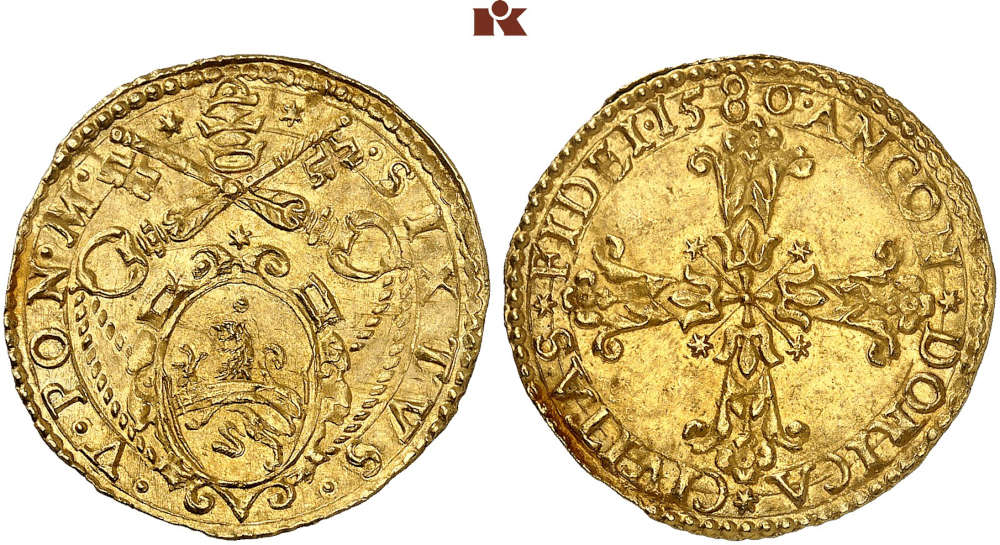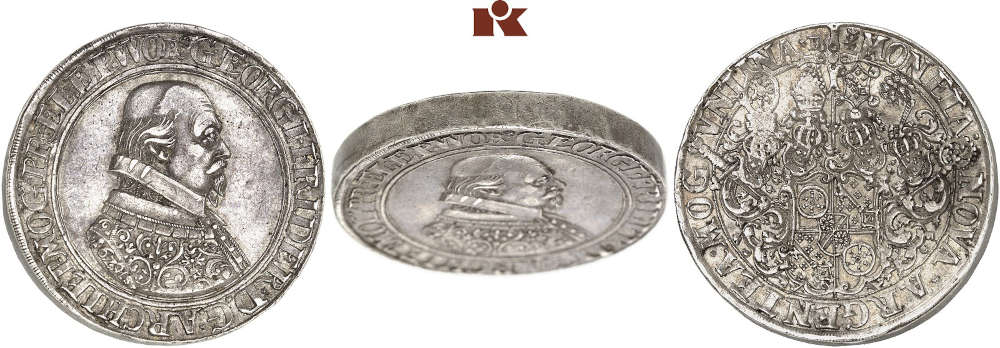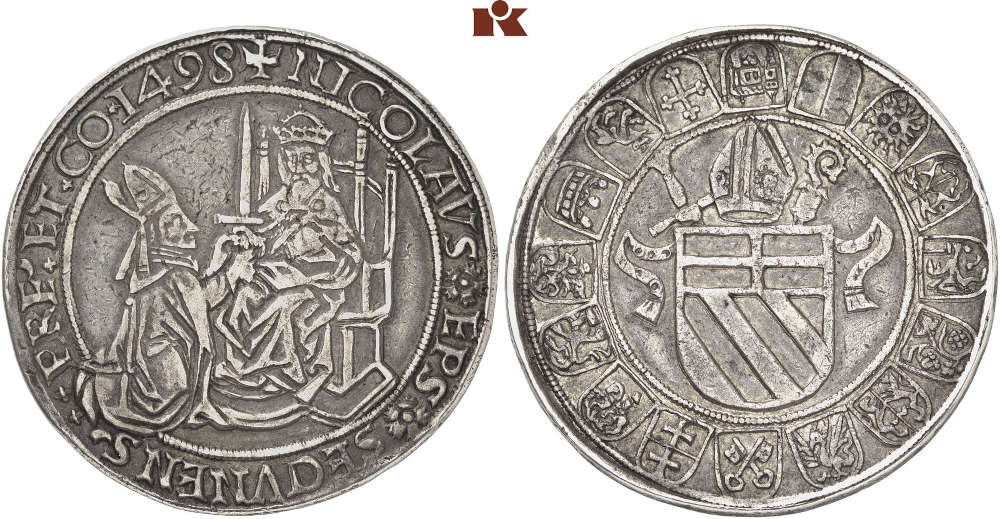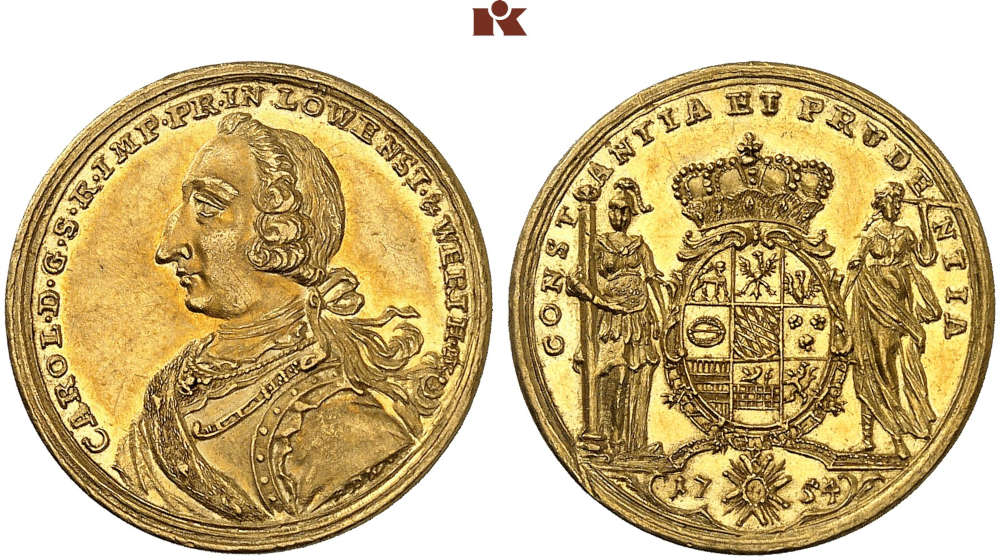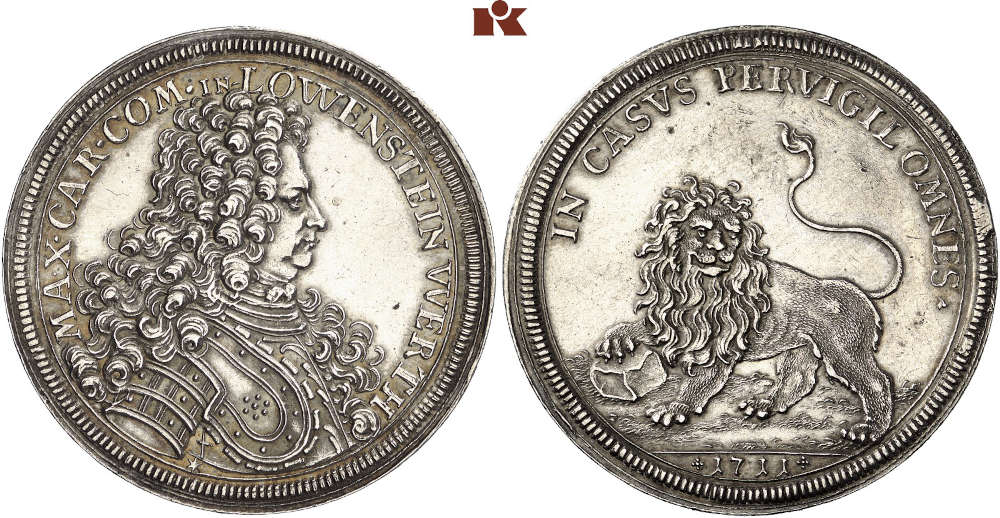Popes, Mainz, Regensburg and Löwenstein: Special Collections at Künker
Künker
Auction 403-406
Coins
18-22 March 2024
D-Osnabrück
As many as four catalogs with coins and medals from medieval and modern times alone will be presented in Künker’s Spring Auction Sales, taking place from 18 to 22 March 2024 in Osnabrück.
Auction 403 contains papal coins and medals from the estate of a south-west German entrepreneur; auction 404 offers the second part of Mainz coins and medals from the Prof. Dr. Eckhart Pick Collection; auction 405 deals with an important special collection of coins from the bishopric and the imperial city of Regensburg; and general catalog 406 does not only include world coins and medals but also a special collection with issues of the counts and princes of Löwenstein-Wertheim. Moreover, an extensive selection of Habsburg talers and ducats is on offer.
In short: 3,240 lots with a total estimate of 4.3m euros eagerly await their new owners. There really is something on offer for everyone. Estimates start in the low two-digit range, although this preview will obviously focus on the more expensive pieces.
Look forward to a rich offer of exquisite world issues!
Auction 403: Coins and Medals of the Popes – The Important Special Collection of a South-West German Entrepreneur
Papal coinage is one of the most fascinating numismatic fields out there. This is also due to the fact that these coins have been coveted souvenirs for a very long time, and were added rather early to prestigious coin collections of the European nobility. Young men who visited Rome as part of their grand tour took them home as they were popular souvenirs and easy to transport.
Therefore, since the late Renaissance, it has been a great business for the papal mint to produce coins and medals that will never enter circulation. Their attractive motifs featuring ecclesiastical ceremonies, buildings, allegories or biblical scenes made these issues the predecessors of modern commemorative coins.
In this regard, you should take a careful look at the extensive catalog for auction 403 with the important special collection of a south-west German entrepreneur. It is worth it! Especially if you closely examine every detail of the carefully designed motifs.
But, of course, auction 403 also contains significantly older pieces. The collector tried to purchase at least one coin of every pope, an ambitious endeavor that was of course doomed to failure regarding late antiquity and the Middle Ages. However, starting with Clement VI (1342-1352) we can find more and more popes; and starting with Pope Martin V (1417-1431) the collection is almost complete and also contains rare sede vacante issues.
Those who love the city of Rome and enjoy extraordinary motifs will certainly be tempted to collect pieces of this highly interesting field themselves after admiring the beautiful images in this catalog.
Auction 404: Mainz Coins and Medals from the Pick Collection – Part II
In 2011, the internationally acclaimed specialist in Mainz coinage Prof. Dr. Pick auctioned off his extensive Mainz collection at Dr. Busso Peus Nachf. He decided to make public his comprehensive holdings as well as the results of his numismatic and historical research. However, he experienced what many collectors experienced before him: after the sale of his collection, he immediately started to build up another one, which will be offered on 19 March 2024 as part II of the Pick Collection in Künker’s auction 404.
Born in 1941, Prof. Dr. Eckhart Pick is one of the most renowned German collectors. Having earned his doctorate in the legal department of the university, he went on to teach at the Johannes Gutenberg University in Mainz before he became a full-time politician. Representing the Social Democratic Party, he was a member of the state parliament of Rhineland-Palatinate from 1985 to 1987. From 1987 to 2002, he helped shape German reunification as a member of Germany’s federal parliament. And as Parliamentary State Secretary of the Federal Minister of Justice Prof. Dr. Herta Däubler-Gmelin, he influenced Germany’s legal landscape from 1998 to 2002.
As a collector, Prof. Pick was committed to his home town of Mainz, one of the major centers of German history. The fate of the Holy Roman Empire was often determined in this very place. Afterall, the Archbishop of Mainz was also the Archchancellor of the German part of the empire. In this position, he was in charge of the election process that determined the new ruler after the king or emperor had died. For this purpose, the archchancellor convened the electors, determined where and when the election was to take place and thus played a crucial role in this process before the Golden Bull of 1356 was adopted.
In his second collection, Prof. Pick mainly focused on the coins that were missing in his first collection. He therefore covered both the Roman mint with a piece by the usurper Laelian, who declared himself emperor at Moguntiacum, as Mainz was called in Roman times, as well as Mainz issues of the Merovingians and Carolingians. The major focal point is on the Archbishopric of Mainz with a series of extremely rare coins and medals of the archbishops. Moreover, connoisseurs can look forward to issues of the city of Mainz, medals relating to Johannes Gutenberg as well as Erfurt issues, a town that belonged of the Electorate of Mainz.
It is to be expected that this catalog of Mainz coins and medals presenting the second part of the Pick Collection will also become a standard reference work.
Auction 405: Regensburg
321 lots with many spectacular issues from the imperial city of Regensburg will be auctioned on 20 March 2024 between 10 a.m. and 1 p.m. The collection mainly focuses on early modern issues, i.e., those of Emperor Maximilian I (1508-1519) – whom historians like to refer to as the last knight – up to pieces from the worldly Principality of Regensburg, which was created by the Imperial Recess of 1803 before the tradition-honored trading city was annexed to the Kingdom of Bavaria in 1810.
The focal point of the collection is on rare ducats and talers, some of which depict fascinating city views that are incredibly rich in detail. This abundant selection of representative coins should not come as a surprise. After all, these pieces were not used for trade purposes but for something else. Regensburg had become the venue of the Perpetual Diet in 1663, a place where envoys from the entire Holy Roman Empire aligned their policies. Leading European powers had high-paid representatives there that often used magnificent coins as diplomatic gifts. At a time when mint masters had the right to transform the gold and silver of private individuals into coins, countless issues were created that catered to the diplomats’ needs.
That is why there are so many beautiful issues from Regensburg, which are sought after by collectors all over the world. They can look forward to a selection of the most beautiful coins from the city on the Danube River.
Auction 406: Issues from Medieval and Modern Times
More than 1,800 lots with coins and medals from medieval and modern times are offered at Künker’s auction 406. No matter what you are interested in, browsing through this catalog is a must. Be it world coins, medieval rarities, issues from the German States, the German Empire, ducats or talers. This catalog contains countless interesting offers, including several special collections.

No. 4687: France / Carolingians. Charlemagne, 768-814. Denarius, 813/4 or a little later, Aachen. One of two known specimens, the only one in private hands. About very fine. Estimate: 20,000 euros.
The portrait denarii of Charlemagne with the title of emperor IMP(erator) AVG(ustus) instead of the usual REX Fr(ancorum) are among the great rarities of medieval numismatics.
Talers and Ducats of the Habsburgs in Auction 406
Let us begin with the large selection of Habsburg issues that will come under the hammer in auction 406. A total of 340 lots perfectly illustrate that there are still fields of numismatic interest that allow collectors to build up large and important collections with comparably little money. The estimates for ducats of attractive quality start as low as at 500 euros and even the rarities are estimated at around 1,500 euros (of course, the hammer price might be higher). The estimates of the talers are even lower and start at 300 euros – even regarding extremely fine specimens!
Of course, this selection also includes great rarities such as the first 1486 guldiner, spectacular multiple ducats such as a quintuple 1636 ducat minted by Ferdinand II in Prague as well as a ten-fold ducat created in 1695 for Leopold I at the Cluj-Napoca (Klausenburg) mint for Transylvania.
This part of the catalog does not only present coins of the Habsburg imperial dynasty; connoisseurs will also find a rich selection of issues of the Austrian princes.
Rarities from Germany
As always, Künker’s focus is on coins from the German States. Excellent quality, great rarities, attractive provenances – no matter what you value most, you will find the perfect coin in Künker’s upcoming auction sales.
Special Collection Löwenstein-Wertheim in Auction 406
The early modern German States consisted of a variety of territories. Some of them were so tiny that their rulers were often mocked abroad. The rulers of Löwenstein-Wertheim were probably also mocked as their principality was particularly small. However, the rulers of such territories still perceived themselves as autonomous princes with high ambitions. How powerful they felt is also reflected by their sophisticated coins. The special collection Löwenstein-Wertheim offered by Künker is a perfect example of this.
In 1597, Ludwig III of Löwenstein-Wertheim adopted a law that obliged his successors to divide their inheritance into equal parts. This resulted in his territory being more and more fragmented, and numerous successors claimed the privilege of minting coins. This historical situation is highly fascinating to collectors. Most of the coins minted by the counts and later the princes of Löwenstein-Wertheim are extremely rare and show many different, often highly interesting depictions.

No. 5172: German New Guinea. 10 New Guinean marks, 1895. Only 2000 specimens minted. Extremely fine to FDC. Estimate: 40,000 euros.
Coins of the German Empire (Auction 406)
Let us round off this preview of the upcoming Künker auction sale of modern coins with a glance at the section of issues from the German Empire. As usual, there is a rich offer of extremely rare gold and silver coins of outstanding quality. We present a few examples.
And do not forget that after the auction is before the auction! On 26 March 2024, Künker’s eLive Premium Auction 407 starts at 10 a.m. featuring coins of Emperor Franz Joseph from the collection of Heinz Tursky, who passed away in 2023.








